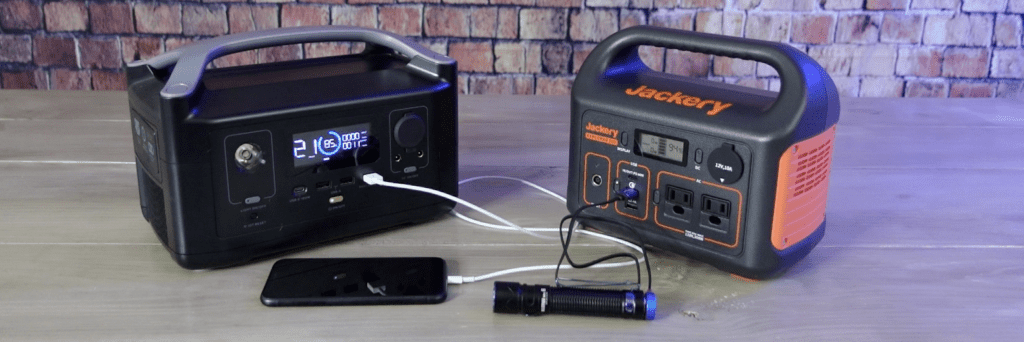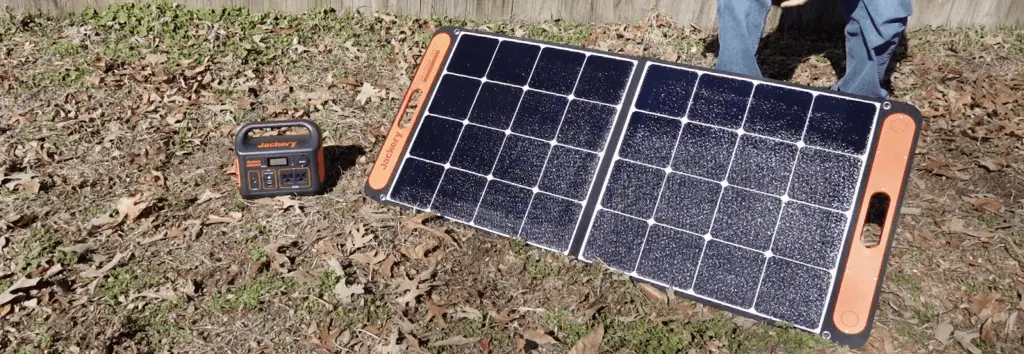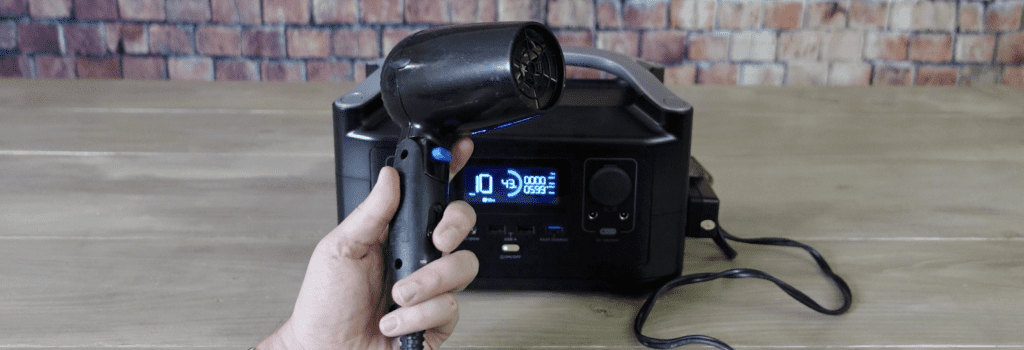The Ecoflow River and Jackery 300 are small, relatively inexpensive solar power stations. They’re both produced by well-known companies, but which one is the best?
The Ecoflow River is a better power station than the Jackery 300. It can power more devices than the Jackery, it charges faster, and its capacity can be doubled by purchasing an extra battery. The Ecoflow River also offers app connectivity and a better display screen.
This article will cover each of these power stations in greater detail, going over their specs along with any other special features that they have.
A Little Backstory
Before we get too deep into the article, I need to disclose something. I was sent the River by Ecoflow earlier this year and they covered the cost of the Jackery 300 so that I could compare the two units on my Youtube channel. However, this article isn’t part of that sponsored agreement.
This article is a reflection of my real-life experiences using both power stations over the past several months. I actually like both of them and use them about the same amount. This is meant to be a helpful perspective from someone who has experience with both if you’re trying to decide which one to purchase.
Basic Specs

The Ecoflow River and Jackery 300 are good options for people looking for a budget-friendly solar power option. Both power stations cost around $300.00, and promotions are common on both of them.
You can purchase them as standalone power stations or as solar generators that include the power station and some solar panels. You can find the individual power stations using the links in the previous paragraph. If you want the full setup, you can find the Ecoflow River Solar Generator by clicking here and the Jackery 300 solar generator by clicking here.
When comparing the Ecoflow River and Jackery 300, the Jackery has a slightly higher overall capacity. The Jackery has a capacity of 293Wh while the River has a capacity of 288Wh. However, the River’s capacity can be doubled by adding an extra battery which can be purchased separately, giving it an overall capacity of 576Wh.
When it comes to output, the Ecoflow River really pulls ahead. The River can handle 600 running watts and up to 1200 surge watts, compared to 300 running watts and 500 surge watts for the Jackery. However, that isn’t the full story. The Ecoflow River can power some devices that would normally require up to 1800 watts. This is thanks to its “X-Boost” feature.
X-Boost basically allows the Ecoflow River to power some devices that normally require up to 1800 running watts. It acts as a governor that prevents the River from overloading and from shutting down. Some devices such as hair dryers will run, just not on full power. Others, like microwaves or refrigerators, may not work since they are a little pickier with their power requirements.
Both the River and Jackery 300 have displays that show you input wattage, output wattage, and percent remaining in both numerical and graphic form. However, the Ecoflow also shows you how much longer it will last at its current output level. The River’s display is also brighter and looks better than the Jackery’s simple LCD display.
Here’s a chart comparing the specs of the Ecoflow River and Jackery 300:
| Ecoflow River | Jackery 300 | |
| Price | $349 MSRP (Ecoflow.com) Promotions are common | $299.99 MSRP (Jackery.com) Promotions are common |
| Overall Capacity | 288Wh Expandable up to 576Wh | 293Wh |
| AC Output | 600W (1200W Surge) Can power devices that normally require up to 1800 watts because of X-Boost feature. | 300W (500W Surge) |
| Charge Time | AC: 1.6 hours 12-Volt Car Adapter: 3 hours (2) 110W Solar Panels: 1.6-3 hours (1) 160W Solar Panel: 2.4-5 hours | AC: 4.5 hours 12-Volt Car Adapter: 5 hours (1) 100W Solar Panel: 5 hours |
| Weight | 11 lbs | 7.1 lbs |
| AC Outputs | 3 | 2 |
| USB-A Outputs | 3 (One is a Fast Charge Port) | 2 (One is a Fast Charge Port) |
| USB-C Outputs | 1 | 1 |
| Car Power Output | 1 | 1 |
| DC5521 Output | 2 | 0 |
| App Connectivity | Yes | No |
What Can the Ecoflow River and Jackery 300 Run?

Both the Ecoflow River and Jackery 300 do a good job keeping small electronics up and running. You should be able to charge your cell phone around 20 times using either power station. The number of charges you get will depend on what kind of phone you have and its battery capacity.
They also both work very well if you need to keep other kinds of batteries charged. These include rechargeable flashlight batteries as well as rechargeable AA and AAAs. This will allow you to keep devices like lights and radios running during a power outage.
Another kind of battery that the Ecoflow River and Jackery 300 can power is power tool batteries. This will allow you to keep tools such as drills and saws running during a disaster. If you have solar panels, you should be able to keep batteries of all sorts powered up for a very long time.
Both power stations will also be able to run other household essentials. These include things like lights and fans as well as other devices like CPAP machines. The River and Jackery 300 can also both power 12-volt refrigerator/freezers, like this one. This will allow you to keep your most important or expensive groceries from spoiling.
You can learn more about 12-volt refrigerator/freezers by checking out this article.
Solar Charging

The Ecoflow River and Jackery 300 can be charged via AC power from a wall outlet or generator, a car power adapter, and from solar panels. The Jackery 300 can be charged via USB-C, however, that may not be a good idea, and I’ll cover why in the next section.
When it comes to solar panels, the Ecoflow River can be connected to either two 110-watt panels or one 160-watt panel. Using two 110-watt panels, it should recharge in 1.6-3 hours. With one 160-watt panel, it will likely take between 2.4 to 5 hours.
The Jackery 300 can only be connected to one 100-watt SolarSaga solar panel and should take around 5 hours to reach full capacity. However, the Jackery panels do offer some advantages.
First, the Jackery panels are much easier to set up than the Ecoflow panels. All you need to do is open them up, pull the stands away from the panel, and set it up. For the Ecoflow panels, you need to remove them from their case, unfold them, attach them to the case using carabiners, and set them upright.
The Jackery panels can also charge USB devices directly. This is nice if your power station is charged but you want to use the panels to charge USB battery banks, flashlights, or other devices. The Ecoflow panels do not have this feature.
Related: Prepper’s Complete Guide to Buying a Generator
What Can the Ecoflow River Do that the Jackery 300 Can’t?

With 300 running watts and 500 surge watts, the Jackery 300 is rather limited in what it can power. Since the Ecoflow River can support greater output wattage and has X-Boost, it will be able to power significantly more devices.
Having X-Boost will allow the River to power many small kitchen appliances, tools, and other household items such as hair dryers or garment steamers. However, it’s important to understand that powering these devices will drain the River’s battery very quickly.
My experience with Ecoflow devices is that if they say that they can run something, then they will. This is great, however, if you aren’t careful, then your power will not last nearly as long as you would expect.
Another big advantage that the Ecoflow River has over the Jackery 300 is that it recharges very quickly. It can go from 0% to 80% in less than an hour and can make it to 100% in just over an hour and a half. The Jackery 300 takes four and a half hours to charge fully using the AC adapter. You can combine the AC adapter with a USB-C PD charger to make it a little faster.
(Note: I have read that using the USB-C port for charging the Jackery 300 has caused some units to stop working. I have never tried this, so I have no experience with it. However, if you own a Jackery 300, I would avoid using this charging method.)
Having such a rapid charge speed is more than just convenient. It will allow you to top the River off quickly if you know a storm is coming your way, and it can help you save fuel when using a gas generator to recharge it.
While the River is designed to be recharged from solar panels, you may need to quickly recharge it from a generator. This could be due to overcast conditions that prevent solar panels from collecting enough energy or for any number of reasons. Since it can recharge fully in just over an hour and a half, this will reduce the amount of time you need to run your generator, thus saving fuel.
Related: 8 Kinds of Technology You Want to Have After a Collapse
Ecoflow River Additional Features
The River also has a few additional features that are nice. It has a flashlight with 3 settings: Low, High, and SOS. The light works well if you need a little extra light in a living area, a night light, or if you need help setting up the device in the dark.
The Ecoflow River is also compatible with the Ecoflow App, which is available in the Apple App Store and Google Play Store. You can use the app to monitor and control the device remotely. This is nice if you want to do things like turn the flashlight on or off from across the room, check the device’s temperature, or turn outputs on or off. However, the app is not necessary for the basic operation of the device.
The River also has more outputs than the Jackery 300, including (2) DC5521 ports. These are useful for powering electronics such as wireless routers.
The Bottom Line
At the end of the day, the Ecoflow River has many advantages over the Jackery 300. It can run more power-hungry appliances and has a long list of features that the Jackery doesn’t. The ability to expand its capacity along with X-Boost makes it incredibly versatile.
However, the Jackery 300 isn’t a bad option either. It has no problem powering devices within its specifications and its portability is very nice. There have been times that I have taken the Jackery 300 with me instead of the River simply because it was smaller and would do what I needed it to do. Also, as stated earlier, the Jackery panels are easier to use and can charge small electronics on their own.
If you just want something that will charge your phone and other small electronics, then both of them will do fine. However, if you want to be able to power some high-wattage devices on occasion, you definitely need the River. If portability and simplicity are your concern, the Jackery 300 is a good option.
